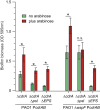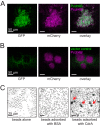CdrA Interactions within the Pseudomonas aeruginosa Biofilm Matrix Safeguard It from Proteolysis and Promote Cellular Packing
- PMID: 30254118
- PMCID: PMC6156197
- DOI: 10.1128/mBio.01376-18
CdrA Interactions within the Pseudomonas aeruginosa Biofilm Matrix Safeguard It from Proteolysis and Promote Cellular Packing
Abstract
Biofilms are robust multicellular aggregates of bacteria that are encased in an extracellular matrix. Different bacterial species have been shown to use a range of biopolymers to build their matrices. Pseudomonas aeruginosa is a model organism for the laboratory study of biofilms, and past work has suggested that exopolysaccharides are a required matrix component. However, we found that expression of the matrix protein CdrA, in the absence of biofilm exopolysaccharides, allowed biofilm formation through the production of a CdrA-rich proteinaceous matrix. This represents a novel function for CdrA. Similar observations have been made for other species such as Escherichia coli and Staphylococcus aureus, which can utilize protein-dominant biofilm matrices. However, we found that these CdrA-containing matrices were susceptible to both exogenous and self-produced proteases. We previously reported that CdrA directly binds the biofilm matrix exopolysaccharide Psl. Now we have found that when CdrA bound to Psl, it was protected from proteolysis. Together, these results support the idea of the importance of multibiomolecular components in matrix stability and led us to propose a model in which CdrA-CdrA interactions can enhance cell-cell packing in an aggregate that is resistant to physical shear, while Psl-CdrA interactions enhance aggregate integrity in the presence of self-produced and exogenous proteases.IMPORTANCEPseudomonas aeruginosa forms multicellular aggregates or biofilms using both exopolysaccharides and the CdrA matrix adhesin. We showed for the first time that P. aeruginosa can use CdrA to build biofilms that do not require known matrix exopolysaccharides. It is appreciated that biofilm growth is protective against environmental assaults. However, little is known about how the interactions between individual matrix components aid in this protection. We found that interactions between CdrA and the exopolysaccharide Psl fortify the matrix by preventing CdrA proteolysis. When both components-CdrA and Psl-are part of the matrix, robust aggregates form that are tightly packed and protease resistant. These findings provide insight into how biofilms persist in protease-rich host environments.
Keywords: CdrA; Pseudomonas aeruginosa; Psl; biofilm; elastase; exopolysaccharides.
Copyright © 2018 Reichhardt et al.
Figures







Similar articles
-
The Versatile Pseudomonas aeruginosa Biofilm Matrix Protein CdrA Promotes Aggregation through Different Extracellular Exopolysaccharide Interactions.J Bacteriol. 2020 Sep 8;202(19):e00216-20. doi: 10.1128/JB.00216-20. Print 2020 Sep 8. J Bacteriol. 2020. PMID: 32661078 Free PMC article.
-
Non-disruptive matrix turnover is a conserved feature of biofilm aggregate growth in paradigm pathogenic species.mBio. 2025 Mar 12;16(3):e0393524. doi: 10.1128/mbio.03935-24. Epub 2025 Feb 21. mBio. 2025. PMID: 39982068 Free PMC article.
-
Untethering and Degradation of the Polysaccharide Matrix Are Essential Steps in the Dispersion Response of Pseudomonas aeruginosa Biofilms.J Bacteriol. 2020 Jan 15;202(3):e00575-19. doi: 10.1128/JB.00575-19. Print 2020 Jan 15. J Bacteriol. 2020. PMID: 31712279 Free PMC article.
-
The Pseudomonas aeruginosa Biofilm Matrix Protein CdrA Has Similarities to Other Fibrillar Adhesin Proteins.J Bacteriol. 2023 May 25;205(5):e0001923. doi: 10.1128/jb.00019-23. Epub 2023 Apr 26. J Bacteriol. 2023. PMID: 37098957 Free PMC article. Review.
-
Pseudomonas aeruginosa biofilm exopolysaccharides: assembly, function, and degradation.FEMS Microbiol Rev. 2023 Nov 1;47(6):fuad060. doi: 10.1093/femsre/fuad060. FEMS Microbiol Rev. 2023. PMID: 37884397 Free PMC article. Review.
Cited by
-
Carbon Starvation Induces the Expression of PprB-Regulated Genes in Pseudomonas aeruginosa.Appl Environ Microbiol. 2019 Oct 30;85(22):e01705-19. doi: 10.1128/AEM.01705-19. Print 2019 Nov 15. Appl Environ Microbiol. 2019. PMID: 31492668 Free PMC article.
-
Distinct types of multicellular aggregates in Pseudomonas aeruginosa liquid cultures.NPJ Biofilms Microbiomes. 2023 Jul 28;9(1):52. doi: 10.1038/s41522-023-00412-5. NPJ Biofilms Microbiomes. 2023. PMID: 37507436 Free PMC article.
-
Breakdown of clonal cooperative architecture in multispecies biofilms and the spatial ecology of predation.Proc Natl Acad Sci U S A. 2023 Feb 7;120(6):e2212650120. doi: 10.1073/pnas.2212650120. Epub 2023 Feb 2. Proc Natl Acad Sci U S A. 2023. PMID: 36730197 Free PMC article.
-
Pseudomonas aeruginosa Biofilm Lifecycle: Involvement of Mechanical Constraints and Timeline of Matrix Production.Antibiotics (Basel). 2024 Jul 24;13(8):688. doi: 10.3390/antibiotics13080688. Antibiotics (Basel). 2024. PMID: 39199987 Free PMC article. Review.
-
Mucoid Pseudomonas aeruginosa Can Produce Calcium-Gelled Biofilms Independent of the Matrix Components Psl and CdrA.J Bacteriol. 2022 May 17;204(5):e0056821. doi: 10.1128/jb.00568-21. Epub 2022 Apr 13. J Bacteriol. 2022. PMID: 35416688 Free PMC article.
References
Publication types
MeSH terms
Substances
Grants and funding
LinkOut - more resources
Full Text Sources
Other Literature Sources
Miscellaneous

